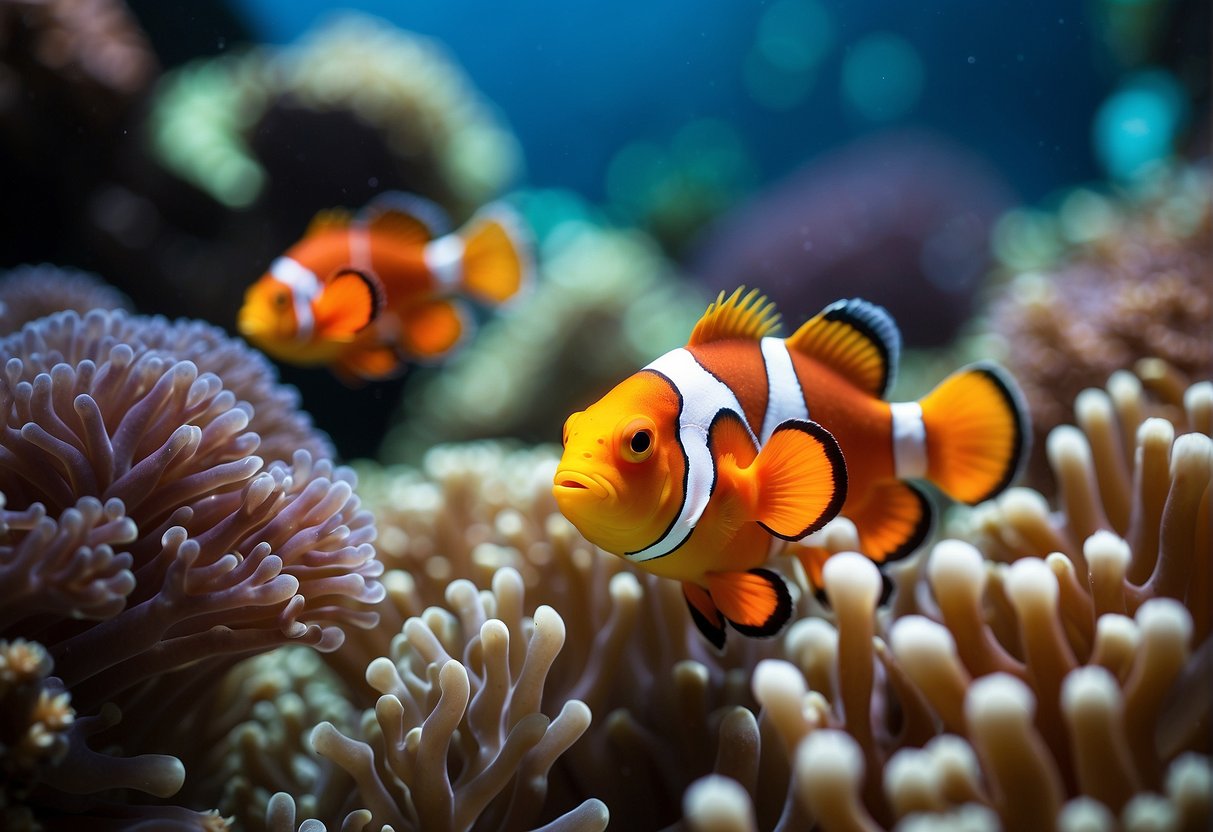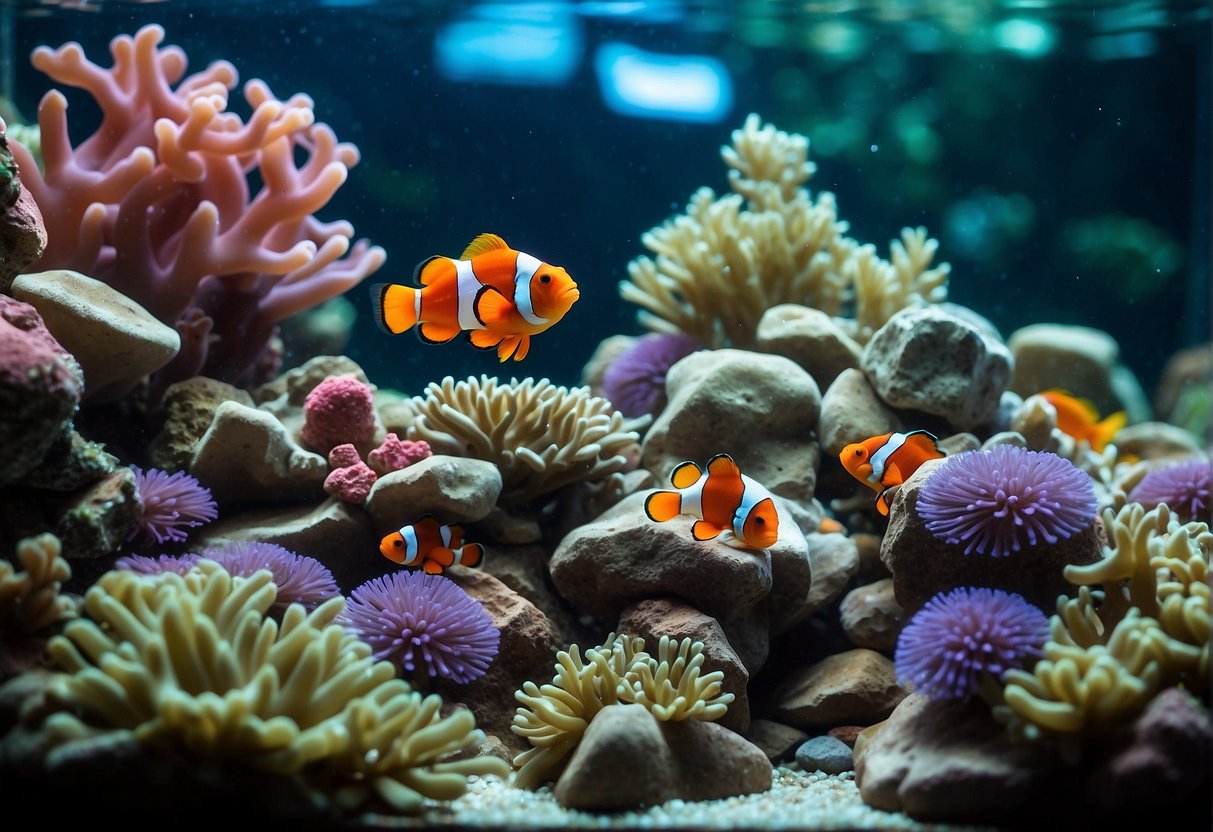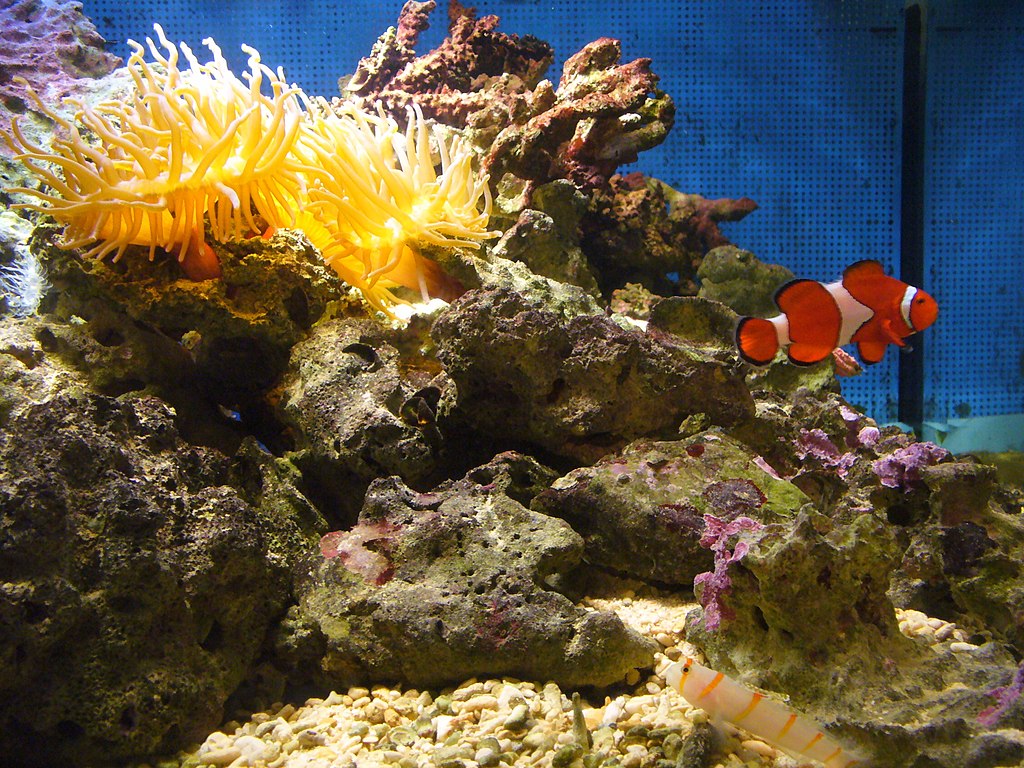Is a 10-Gallon Tank Suitable for Clownfish? (Pros, Cons, and Alternatives)

Clownfish are a vibrant and captivating choice for saltwater aquariums. Their unique patterns and personable behavior make it easy to see why they’re so popular. But before setting up your clownfish tank, there’s one crucial question: is a 10-gallon tank the right size?
While a 10-gallon tank can seem tempting, some important factors must be considered. This article explores the pros and cons of a 10-gallon clownfish tank and offers alternatives to ensure your clownfish have a healthy and fulfilling environment.
Understanding the Basics of a Clownfish Tank

Species Overview
Clownfish are a popular and colorful marine fish species that are often the subject of home aquariums. These charming fish are known for their vibrant colors and unique symbiotic relationship with anemones. There are about 30 different clownfish species, the most common being the Ocellaris Clownfish and the Percula Clownfish. They are saltwater fish known for their adaptability to various water conditions.
Minimum Tank Size Requirements
When considering a clownfish tank, it is important to understand their minimum tank size requirements. While some people may attempt to house clownfish in a 10-gallon tank, it is not the ideal size for these fish. Experienced fishkeepers recommend a minimum 20-gallon tank for a single clownfish, and an additional 10-15 gallons for each additional fish. This ensures that they have enough space to swim and establish territories.
A suitably sized tank supports the well-being of the clownfish and helps maintain stable water conditions. Larger tanks allow for a more stable environment, as they are less likely to experience drastic changes in water quality and temperature; this is essential for the health of saltwater fish.
One major factor to consider in a clownfish tank setup is water flow. Maintaining a medium water flow is necessary to help the clownfish move around comfortably. This can be achieved by adjusting the water flow from the filtration system or by adding rocks and decorations that help to create water flow patterns within the tank.
Essential Equipment for Your Aquarium
Filtration Systems
A proper filtration system is crucial for maintaining a healthy environment for your clownfish. Filters work by establishing a colony of useful bacteria that convert dangerous ammonia into less hazardous nitrates, a process known as the nitrogen cycle. This conversion is necessary to keep your clownfish healthy, as ammonia buildup can be toxic to fish.
There are three primary types of filtration systems to consider:
- Mechanical filters remove debris such as uneaten food and fish waste from the water. This helps to maintain water clarity and prevent the buildup of harmful substances.
- Biological filters provide a surface for beneficial bacteria to grow. These bacteria break down toxic ammonia and nitrites into less harmful nitrates.
- Chemical filters use specialized media to remove harmful compounds from the water, such as activated carbon, to remove odors and discoloration.
It’s essential to choose the right filter for your tank size and the specific needs of your clownfish.
Aquarium Lighting Options
Proper lighting is another crucial aspect of your 10-gallon clownfish tank setup. Clownfish are reef animals that thrive in well-lit environments. Here are some popular options for aquarium lighting:
- Fluorescent lights: These are energy-efficient and offer various color options. They can provide the necessary light spectrum for coral growth, essential for a clownfish habitat.
- LED lights: LED aquarium lights are becoming increasingly popular due to their energy efficiency and customizable color options. They can mimic natural sunlight patterns, providing an ideal environment for clownfish and any corals in your tank.
- Compact fluorescent lights (CFL): CFLs are another energy-efficient option. They emit a more intense light than standard fluorescent lights and are suitable for supporting coral growth.
Water Parameters and Quality Management
Regular Water Changes
One of the critical aspects of maintaining a healthy 10-gallon clownfish tank is ensuring proper water quality. Regular water changes play a significant role in removing waste, controlling nitrate levels, and maintaining the stability of the overall environment.
Changing approximately 10-15% of the tank’s water every week is essential. During the water change, you must also carefully balance the salinity, pH, and ammonia levels to simulate ocean conditions accurately.
Note: Before adding new water, ensure it is the same temperature, salinity, and pH level as the existing water to avoid stressing the clownfish or causing fluctuations in the tank’s conditions.
Maintaining Ideal Conditions
Clownfish thrive in specific water conditions within their saltwater aquarium. To keep your fish healthy, you should regularly monitor the following parameters:
- Temperature: Maintain a stable temperature between 75-80°F.
- Salinity: Maintain a salinity level of 1.021-1.026 sg.
- pH: Aim for a pH range of 8.1-8.4.
- Ammonia and Nitrite: Keep their levels as close to 0 ppm as possible.
- Nitrate: Maintain nitrates below 20 ppm.
One way to ensure a stable environment is to use a good quality heater and proper equipment to measure and adjust the aquarium’s water parameters. Besides, having a reliable filtration system and using regular maintenance practices like cleaning the substrate and removing algae is necessary too.
Selecting Compatible Tank Mates
Potential Clownfish Companions
When setting up a 10-gallon clownfish tank, it is crucial to choose suitable tank mates that can live harmoniously with your clownfish. These compatible species should be peaceful and thrive in a saltwater environment. A few good options include small schooling fish like Cardinal tetras and Neon tetras, as well as some peaceful bottom-dwellers like Corydoras catfish.
Invertebrates can also make excellent tank mates for clownfish. Adding some Nerite snails or Blue Leg hermit crabs can help maintain a clean tank while adding diversity to the tank’s inhabitants.
Here are some compatible species to consider for a 10-gallon clownfish tank:
- Fish: Cardinal tetras, Neon tetras, Corydoras catfish, and Firefish goby
- Invertebrates: Nerite snails, Blue Leg hermit crabs
Avoiding Aggressive Interactions
It is essential to avoid potential aggression between tank mates and ensure a peaceful environment for all. Clownfish can sometimes be aggressive, so selecting companions that can coexist without conflict is vital. Damselfish, for instance, are not recommended as tank mates due to their similar appearance and consequent territorial disputes with clownfish.
A few guidelines to follow when choosing compatible tank mates for clownfish:
- Select smaller species than clownfish to minimize territorial disputes and aggressive behavior.
- Avoid fish that compete for territory or disrupt harmony within the tank.
- Focus on fish with peaceful temperaments and hardiness, as these traits can help minimize conflict and promote coexistence.
Feeding and Nutrition
Dietary Requirements
Clownfish are omnivorous creatures requiring a balanced diet consisting of meaty foods and vegetable matter. Their diet plays a crucial role in maintaining their health and color vibrancy1. Some common food options for clownfish include:
- Frozen foods: Mysis shrimp, brine shrimp, and plankton.
- Pellets and flake foods: High-quality marine fish pellets and flakes designed for omnivorous species.
- Vegetable matter: Spirulina and marine algae.
It’s essential to provide variety in their diet to ensure they receive all the necessary nutrients2.
Special Feeding Considerations
For juvenile clownfish, offering smaller-sized food options is important to ensure they can consume it comfortably. As they grow, they gradually increase the size of their food.
Feeding frequency should be adjusted according to the age and size of the clownfish. Younger fish should be fed small amounts more frequently3, while mature clownfish can be fed twice daily to maintain an optimal nutritional balance.
Clownfish also benefit from a feeding schedule that mimics their natural feeding habits, such as scattering food throughout the day for them to forage on and having more substantial meals at specified times. Maintaining a consistent feeding schedule promotes healthy growth and reduces stress on the fish4.
Aquatic Environment Enrichment
Aquascaping with Live Rock
In a 10-gallon clownfish tank, aquascaping with live rock helps to provide a natural and visually appealing environment. Live rocks are porous and full of beneficial bacteria, creating a stable biological filtration system for your aquarium. Additionally, they provide hiding spots and territory areas for your clownfish to explore and establish a healthy environment.
When implementing live rock, creating a stable structure that will not topple over and injure your clownfish is important. Place larger rocks at the bottom of the tank and gradually build up the structure with smaller rocks, ensuring stability. You can also use reef-safe glue or epoxy to secure the rocks into place.
Introducing Anemones for Clownfish
Introducing anemones is another vital aspect of enriching the aquarium environment. Clownfish are renowned for their symbiotic relationship with anemones in their natural habitat, which helps protect them from predators. In return, clownfish help to feed anemones by bringing them food and removing debris.
Here is a brief table highlighting essential parameters for a clownfish-anemone setup:
| pH Level | Temperature (°F) | Temperature (°C) |
|---|---|---|
| 8.0-8.4 | 73-80 | 22.8-27 |
In a 10-gallon tank, it is crucial to ensure proper anemone care since they have specific requirements, such as strong water flow, stable temperatures, and adequate lighting. Choose anemone species that are well-suited for smaller tanks and easy to care for, such as bubble tip anemones (Entacmaea quadricolor).
Once the anemone acclimates to the tank, it is not uncommon for the clownfish to interact with them. Make sure you give your anemone enough space and do not overcrowd the tank with additional decorations or structures.
Health and Growth: From Juveniles to Adults
Monitoring Clownfish Growth
When raising clownfish in a 10-gallon tank, one of the essential aspects to consider is monitoring their growth. Juvenile clownfish start small, but their adult size can be up to 3 inches as they grow. Keep track of your clownfish’s growth and ensure the tank provides ample space as they reach their full potential.
Growth rate and lifespan
- Juvenile clownfish typically grow at a steady rate
- They can reach adult size in approximately 1–2 years
- Clownfish have a lifespan of around 3–6 years
Identifying and Addressing Health Issues
Maintaining the optimal water conditions in a 10-gallon tank is crucial for the health and well-being of your clownfish. Stable reef-quality water with a mature biological filter helps minimize the risk of ammonia and nitrate poisoning.
Common health issues faced by clownfish include:
- Fin rot: Caused by bacteria or fungus, leading to frayed or decaying fins. It can be treated with over-the-counter medications and maintaining optimal water conditions.
- Ich: A parasitic infection causing white spots on the fish’s body. Treatment includes medication and raising the water temperature slightly.
Alternatives: Upgrading to a Larger Setup
If you’re truly committed to clownfish, a larger tank, like a 20-gallon, provides significant benefits:
- More space and stability: A larger tank allows your clownfish ample room to swim and establish territories. It also helps maintain water stability, as a larger volume is less prone to drastic changes in temperature and water quality.
- Host Anemone: Many popular clownfish species form symbiotic relationships with anemones. A 20-gallon tank gives you the space to safely introduce an anemone, enhancing your aquarium’s visual appeal and biological diversity.
- Additional Tank Mates: With more room, you can consider peaceful tank mates like gobies, blennies, or small wrasses. This adds diversity and interest to your tank.
What a 20-Gallon Setup Could Include:
- Filtration: A hang-on-back filter or canister filter suitable for a 20-gallon tank.
- Lighting: A stronger LED or T5 fluorescent lighting system to support potential coral growth with greater light penetration.
- Aquascaping: More live rock for filtration, hiding spaces, and room for a suitable anemone.
Final Thoughts on Keeping a Clownfish in a 10 Gallon Tank
When considering a 10-gallon clownfish tank, it is essential to note that while some clownfish species can adapt to this tank size, other species such as the maroon clownfish may require a larger tank.
A 10-gallon tank provides a limited space, and maintaining the water quality and stable environment becomes more challenging in smaller tanks. Therefore, it is advised to start with a slightly larger tank for convenience and the well-being of the fish.
In order to have a thriving clownfish in your 10-gallon tank, there are some key aspects to keep in mind:
- Aquarium setup: Ensure proper equipment for the tank is in place, such as a heater, filter, and light. Also include live rock and sand to create hiding spots and establish a healthy environment for the fish.
- Water quality: Clownfish are sensitive to changes in water quality, so regular testing and maintenance are crucial. Pay attention to parameters such as salinity, pH, and temperature.
- Tank mates: Select appropriate tank mates for the clownfish, considering the available space. Some good options include small schooling fish like Cardinal tetras and peaceful invertebrates like Nerite snails or Blue Leg hermit crabs.
If breeding clownfish is a goal, a 10-gallon tank may not be the best option as the breeding process creates additional challenges and requires more space. The fish will need a quiet and safe space to lay eggs, and the fry will need room to grow. A 20-gallon tank or larger is recommended for breeding purposes which would give the fish ample space and make it easier to maintain the water quality.


